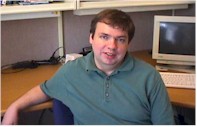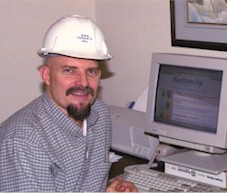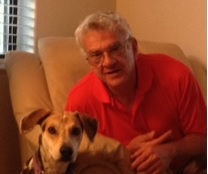|
|
A number of volunteers, and past volunteers, from varying locations, have banded together in a virtual team to bring Hardhats.org to life. They each bring unique skills to the effort and find their reward in the work, a job well done, and producing something that will benefit others. We hope you will join them in the effort to build a Hardhats community.
Gregory Woodhouse, Greg Kreis, George Timson, Lloyd Milligan
|
home page: http://www.wnetc.com/home.html resource page: http://www.wnetc.com/resource/
|
My academic background is in mathematics where I graduated with highest honors, and also hold a Masters degree. Unfortunately, it wasn't long after finishing my Masters that I realized my heart wasn't in mathematics, per se, and I ended up taking temporary position with the USGS which consisted of programming (C) and Unix system administration. I now work with the VA, San Francisco IRM Field Office, in QA. My biggest interest is in distributed/collaborative computing and TCP/IP. I haven't entirely given up on the idea of doing a Ph.D., though I don't know how likely I am to pursue this option. If I did do a Ph.D., it would definitely be in computer science, and I imagine my dissertation as being on some aspect of building distributed systems over wide area networks. I have a long standing interest in electronic mail, and have been running mailing lists (both moderated and non-moderated) for the past four years. I am also actively following the activities of the IETF (Internet Engineering Task Force, essentially the TCP/IP equivalent of MDC) on several fronts. I've also been maintaining an internal web page with the latest RFCs and Internet-Drafts in the following areas: HTTP, Mail, MIME (which I treat separately because of its scope and relevance to HTTP), and URIs (though I don't try to keep up with every URL scheme. I am, however, closely following the NAPTR proposal for URNs.) I also have a growing interest in X.400 and have been studying the work of the MIXER (MIME Internet X.400 Enhanced Relay) group. For the record, I think the Internet mail handling system (as it exits today) and X.400 are quite close in capabilities--there areas where X.400 excels and areas where Internet mail excels, with neither being superior to the other. I also have an interest in web page design and have, to date, built one commercial site. So far, I have done my CGI work in Perl (both 4 and 5). I have an interest in Java, but am still coming up to speed in this area, and haven't attempted to use it for any production work. |
|
|
M has been my primary computer language since 1979 and I have been teaching File Manager and M since 1984. I worked for the Department of Veteran's Affairs from 1983-1985 where I programmed parts of the Inpatient and Outpatient Pharmacy software. Leaving the DVA to start up a software company, I successfully lead several projects for adapting VISTA (DHCP) to commercial settings. I am President of my own consulting and training company for VistA-related projects - Pioneer Data Systems. In addition to programming in MUMPS, C#, With the web, it is now feasible to take a whole new look at software
support, documentation, application design, etc. Add to this opensource MUMPS
(GT.M for example) on an opensource OS (Linux), running opensource |
|
|
After graduating from Harvard, I was lucky enough to be
hired by Neil Pappalardo and Curt Marble as MEDITECH's first programmer in
1969. Initial conditions determine trajectory; I've been programming in MUMPS
ever since. In the mid-70's I worked on the on-line Criminal Court system in In 1985, I left the VA to become a partner in a startup company, DI*STAR. Our company eventually teamed with Science Applications International of San Diego to implement the DOD's "TRIMIS" hospital-information project. The large suite of FileMan-based software produced by the TRIMIS ("CHCS") project is now deployed in DOD medical facilities around the world. Since SAIC acquired DI*STAR in 1989, I've been for the most part an independent consultant. I've worked for the VA, the City of Berkeley, and for Medsphere Systems Corporation. Computers are fun, but my first love is still classical music. |
|
|
In my first career as a VA Research Psychologist I learned computer programming in the context of laboratory instrumentation. I first heard of MUMPS in a telephone conversation with Marty Johnson in September, 1978. Although not obvious at the time, this was the beginning of an adventure that has continued to the present. From the middle 1980s I worked with DHCP (later VistA) at the |
Search | Home | MUMPS | Fileman | Kernel | C/S, Mailman, Web | Programmer Tools | Applications










